
The Baltic languages belong to the Balto-Slavic branch of the Indo-European language family. Baltic languages are spoken by the Balts, mainly in areas extending east and southeast of the Baltic Sea in Northern Europe.

The Balts or Baltic people are an ethno-linguistic group of people who speak the Baltic languages of the Balto-Slavic branch of the Indo-European languages.
Sudovian is an extinct Western Baltic language of Northeastern Europe. Sudovian was closely related to Old Prussian. It was formerly spoken southwest of the Nemunas river in what is now Lithuania, east of Galindia and north of Yotvingia, and by exiles in East Prussia.

The East Slavs are the most populous subgroup of the Slavs. They speak the East Slavic languages, and formed the majority of the population of the medieval state Kievan Rus', which all three independent East Slavic states claim as their cultural ancestor. By the seventeenth-century, the East Slavs eventually evolved into the Belarusians, the Russians, the Rusyns, and the Ukrainians.
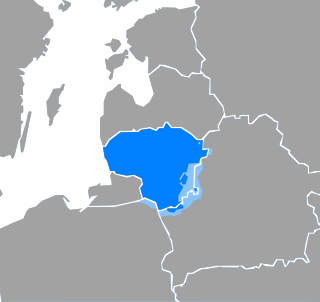
Lithuanian is a Baltic language belonging to the Balto-Slavic branch of the Indo-European language family. It is the official language of Lithuania and one of the official languages of the European Union. There are about 2.8 million native Lithuanian speakers in Lithuania and about 200,000 speakers elsewhere.
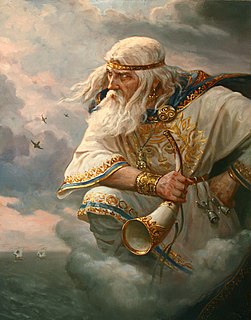
Stribog is a god in Slavic mythology found in three East Slavic sources, whose cult may also have existed in Poland. The sources do not inform about the functions of the god, but nowadays he is most often interpreted as a wind deity who distributes wealth.
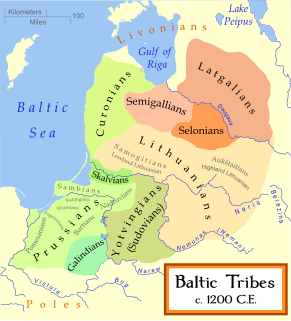
The Yotvingians were a Western Baltic people who were closely tied to the Old Prussians. The linguist Petras Būtėnas asserts that they were closest to the Lithuanians. The Yotvingians contributed to the formation of the Lithuanian state.

The Balto-Slavic languages is a branch of the Indo-European family of languages. It traditionally comprises the Baltic and Slavic languages. Baltic and Slavic languages share several linguistic traits not found in any other Indo-European branch, which points to a period of common development. Although the notion of a Balto-Slavic unity has been contested, there is now a general consensus among specialists in Indo-European linguistics to classify Baltic and Slavic languages into a single branch, with only some details of the nature of their relationship remaining in dispute.

Galindians were two distinct, and now extinct, tribes of the Balts. Most commonly, Galindians refers to the Western Galindians who lived in the southeast part of Prussia. Less commonly, it is used for a tribe that lived in the area of what is today Moscow.

The Nadruvians were a now-extinct Prussian tribe. They lived in Nadruvia, a large territory in northernmost Prussia. They bordered the Skalvians on the Neman (Nemunas) River just to the north, the Sudovians to the east, and other Prussian tribes to the south and west. Most information about the clan is provided in a chronicle by Peter von Dusburg.

The Zarubintsy or Zarubinets culture was a culture that from the 3rd century BC until the 1st century AD flourished in the area north of the Black Sea along the upper and middle Dnieper and Pripyat Rivers, stretching west towards the Southern Bug river. Zarubintsy sites were particularly dense between the Rivers Desna and Ros as well as along the Pripyat river. It was identified around 1899 by the Czech-Ukrainian archaeologist Vikentiy Khvoyka and is now attested by about 500 sites. The culture was named after finds of cremated remains in the village of Zarubyntsi on the Dnieper.
Narva culture or eastern Baltic was a European Neolithic archaeological culture found in present-day Estonia, Latvia, Lithuania, Kaliningrad Oblast, and adjacent portions of Poland, Belarus and Russia. A successor of the Mesolithic Kunda culture, Narva culture continued up to the start of the Bronze Age. The culture spanned from c. 5300 to 1750 BC. The technology was that of hunter-gatherers. The culture was named after the Narva River in Estonia.
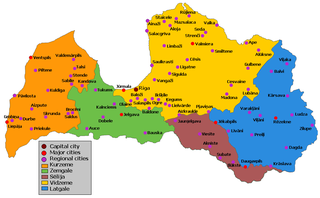
Selonia, also known as Augšzeme, is one of the Historical Latvian Lands encompassing the eastern part of the historical region of Semigallia as well as a portion of northeastern Lithuania. Its main city and cultural center is Jēkabpils. The Selonian language has become extinct, though some of the inhabitants still speak a Latgalian dialect.
The linguistic classification of the ancient Thracian language has long been a matter of contention and uncertainty, and there are widely varying hypotheses regarding its position among other Paleo-Balkan languages. It is not contested, however, that the Thracian languages were Indo-European languages which had acquired satem characteristics by the time they are attested.

The first known record of the name of Lithuania is in a 9 March 1009 story of Saint Bruno recorded in the Quedlinburg Chronicle. The Chronicle recorded a Latinized form of the Old Church Slavonic word for Lithuania—Литва (Litva)—Latinized as Litva. Although it is clear the name originated from a Baltic language, scholars still debate the meaning of the word.

The Western Baltic culture was the westernmost branch of the Balts, representing a distinct archaeological culture of the Bronze Age and Iron Age, along the southern coast of the Baltic Sea. It is a zone of several small archaeological cultures that were ethnically Baltic and had similar cultural features. They included tribes such as the Old Prussians, Galindians, Yotvingians and Skalvians, in addition to the little-known Pomeranian Balts or Western Balts proper, in the area now known as Pomerania.
Baltistics is a multidisciplinary study of the language and culture of the Baltic nations. Baltistics by its subject splits into Lithuanistics, Latvistics, Prussistics, etc. Special attention is paid to the language studies, especially to the reconstruction of the Proto-Baltic language, which some linguists have argued is the same as the Proto-Balto-Slavic language. Currently there are about 30 centres of Baltistics, most of them based in Europe, the University of Vilnius considered to be the most active centre.
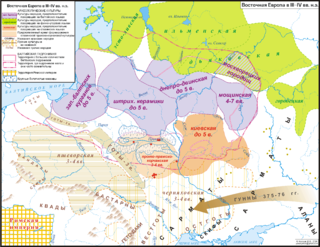
The Moshchiny culture (Russian: Мощинская культура) was an archaeological culture of the Iron Age from the 4th to the 7th century in present-day western Russia.












